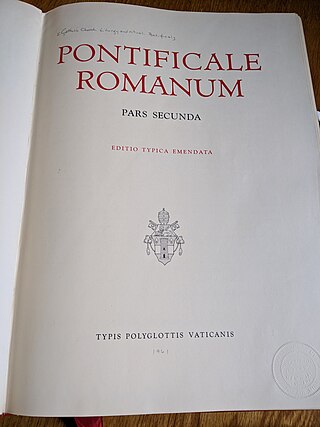Related Research Articles

The Ambrosian Rite is a Catholic Western liturgical rite, named after Saint Ambrose, a bishop of Milan in the fourth century, which differs from the Roman Rite. It is used by some five million Catholics in the greater part of the Archdiocese of Milan, in some parishes of the Diocese of Como, Bergamo, Novara, Lodi, and in the Diocese of Lugano, Canton of Ticino, Switzerland.
Ecclesiastical Latin, also called Church Latin or Liturgical Latin, is a form of Latin developed to discuss Christian thought in Late Antiquity and used in Christian liturgy, theology, and church administration down to the present day, especially in the Catholic Church. It includes words from Vulgar Latin and Classical Latin re-purposed with Christian meaning. It is less stylized and rigid in form than Classical Latin, sharing vocabulary, forms, and syntax, while at the same time incorporating informal elements which had always been with the language but which were excluded by the literary authors of Classical Latin.
In the Western Church of the Early and High Middle Ages, a sacramentary was a book used for liturgical services and the mass by a bishop or priest. Sacramentaries include only the words spoken or sung by him, unlike the missals of later centuries that include all the texts of the mass whether read by the bishop, priest, or others. Also, sacramentaries, unlike missals, include texts for services other than the mass such as ordinations, the consecration of a church or altar, exorcisms, and blessings, all of which were later included in Pontificals and Rituals instead.
In religious and magical practice, insufflation and exsufflation are ritual acts of blowing, breathing, hissing, or puffing that signify variously expulsion or renunciation of evil or of the devil, or infilling or blessing with good.

The Roman Ritual is one of the official liturgical books of the Roman Rite of the Latin Church of the Catholic Church. It contains all of the services that a priest or deacon may perform; and are not contained in the Missale Romanum, Pontificale Romanum, or Caeremoniale Episcoporum, but for convenience does include some rituals that one of these books contains.

The Cæremoniale Episcoporum is a liturgical book that describes the church services to be performed by bishops of the Latin Church of the Catholic Church.

Pre-Tridentine Mass refers to the variants of the liturgical rite of Mass in the West before 1570, when, with his bull Quo primum, Pope Pius V made the Roman Missal, as revised by him, obligatory throughout the Latin Church, except for those places and congregations whose distinct rites could demonstrate an antiquity of two hundred years or more.

Latin liturgical rites, or Western liturgical rites, is a large family of liturgical rites and uses of public worship employed by the Latin Church, the largest particular church sui iuris of the Catholic Church, that originated in Europe where the Latin language once dominated. Its language is now known as Ecclesiastical Latin. The most used rite is the Roman Rite.
The Ordines Romani are collections of documents that are the rubrics for various liturgical services, including the early Medieval Mass, of the Roman Rite. There are about 50 recognized Ordines Romani.

Annibale Bugnini was a Catholic prelate. Ordained in 1936 and named archbishop in 1972, he was secretary of the commission that worked on the reform of the Roman Rite that followed the Second Vatican Council. Both critics and proponents of the changes made to the Mass, the Liturgy of the hours and other liturgical practices before and after Vatican II consider him a dominant force in these efforts. He held several other posts in the Roman Curia and ended his career as papal nuncio to Iran, where he acted as an intermediary during the Iran hostage crisis of 1979 to 1981.
Romano-Germanic may refer to:

St. Alban's Abbey, Mainz originated as a Benedictine abbey, founded in 787 or 796 by Archbishop Richulf (787–813) in honour of Saint Alban of Mainz, located to the south of Mainz on the hill later called the Albansberg. It was turned into a collegiate foundation (Herrenstift) in 1442. The buildings were entirely destroyed in 1552, although the foundation retained a legal existence until its formal dissolution in 1802.

The Roman Pontifical, in Latin Pontificale Romanum, is the pontifical as used by the Roman Rite of the Catholic Church. It is the liturgical book that contains the rites and ceremonies usually performed by bishops of the Roman Rite.

A liturgical book, or service book, is a book published by the authority of a church body that contains the text and directions for the liturgy of its official religious services.

The liturgical books of the Roman Rite are the official books containing the words to be recited and the actions to be performed in the celebration of Catholic liturgy as done in Rome. The Roman Rite of the Latin or Western Church of the Catholic Church is the most widely celebrated of the scores of Catholic liturgical rites. The titles of some of these books contain the adjective "Roman", e.g. the "Roman Missal", to distinguish them from the liturgical books for the other rites of the Church.
A pontifical is a Christian liturgical book containing the liturgies that only a bishop may perform. Among the liturgies are those of the ordinal for the ordination and consecration of deacons, priests, and bishops to Holy Orders. While the Roman Pontifical and closely related Ceremonial of Bishops of the Roman Rite are the most common, pontificals exist in other liturgical traditions.
The Rite of Braga is a Catholic liturgical rite associated with the Archdiocese of Braga in Portugal.
Ad multos annos is a Latin acclamation for celebrations, and also a hymn used in the rites of the Orthodox and Catholic churches.

In the Catholic Church, preconciliar Latin liturgical rites coexist with postconciliar rites. In the years following the Second Vatican Council, Pope Paul VI initiated significant changes. Some of Paul VI's contemporaries, who considered the changes to be too drastic, obtained from him limited permission for the continued use of the previous Roman Missal. In the years since, the Holy See has granted varying degrees of permission to celebrate the Roman Rite and other Latin rites in the same manner as before the council. The use of preconciliar rites is associated with traditionalist Catholicism.
The Eastern Catholic Churches of the Catholic Church utilize liturgies originating in Eastern Christianity, distinguishing them from the majority of Catholic liturgies which are celebrated according to the Latin liturgical rites of the Latin Church. While some of these sui iuris churches use the same liturgical ritual families as other Eastern Catholic churches and Eastern churches not in full communion with Rome, each church retains the right to institute its own canonical norms, liturgical books, and practices for the ritual celebration of the Eucharist, other sacraments, and canonical hours.
References
- The Sacraments, Robert Cabié, trans. Matthew O'Connell, Liturgical Press, 1988 ISBN 0-8146-1365-9 Google Books
- Saint James's Catapult: The Life and Times of Diego Gelmírez of Santiago de Compostela, Richard A. Fletcher, Clarendon Press, 1984, ISBN 0-19-822581-4 online cache
- ↑ The Cracow Pontifical (Pontificale Cracoviense saeculi XI) Cracow, Jagellonian Library, MS.2057, Zdzisław Obertynski, Henry Bradshaw Society, London, 1977, ISBN 0-907077-17-X
- ↑ Cracow Pontifical, Boydell & Brewer facsimile description